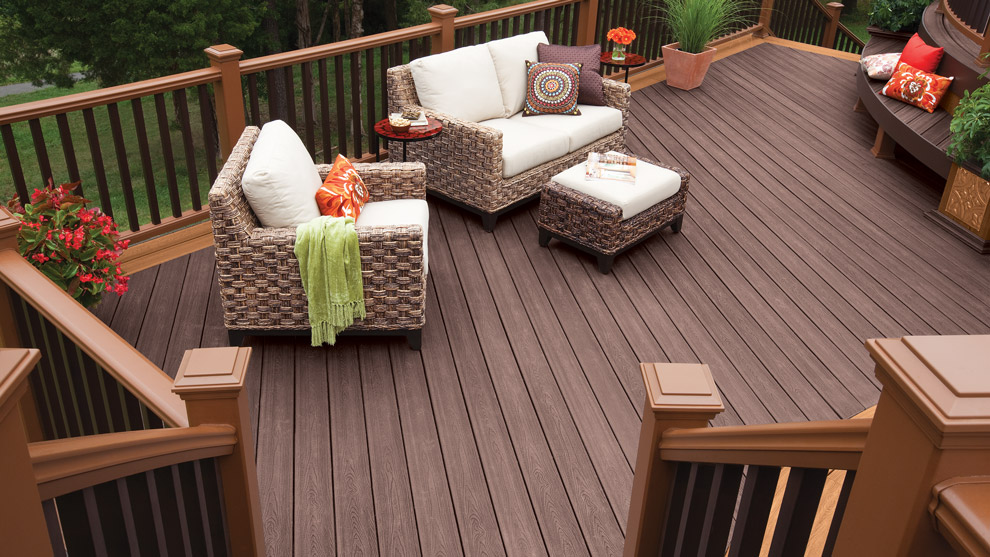Building the perfect deck starts with selecting the suitable materials. Your choice of decking materials affects the aesthetic appeal of your outdoor space and influences maintenance requirements, longevity, and cost. In this guide, we’ll demystify the world of deck materials, focusing on wood, composite, and alternative options to help you make an informed decision when creating your unique deck.
1. Traditional Wood Decking:
Wood decking is a classic choice appreciated for its natural beauty and warmth. The most common wood species used for decking include:
- Cedar: Known for its natural resistance to insects and decay, cedar is a popular choice. Its reddish-brown color and appealing aroma create a charming ambiance.
- Redwood: Similar to cedar, redwood offers natural resistance to decay and insects. It boasts a striking reddish hue that can be preserved or grayed naturally over time.
- Pressure-Treated Pine: Pressure-treated wood is an economical option. It’s pine that has been chemically treated to resist decay and insects. While it may lack the aesthetics of cedar or redwood, it’s a durable and cost-effective choice.
Pros of Wood Decking:
- Natural beauty and warmth.
- Affordable initial cost.
- Repairable and customizable.
- Suitable for staining or painting in various colors.
Cons of Wood Decking:
- Regular maintenance, including sealing or staining.
- Susceptible to rot, decay, and insect damage without proper care.
2. Composite Decking:
Composite decking is a popular alternative to traditional wood. It combines wood fibers with plastic to create a durable and low-maintenance product. The appearance of composite decking closely mimics the look of natural timber, offering various color and texture options.
Pros of Composite Decking:
- Low maintenance; no need for staining or sealing.
- Resistant to rot, decay, and insects.
- Available in various colors and textures.
- Longevity typically comes with extended warranties.
Cons of Composite Decking:
- Higher initial cost compared to wood.
- It can get hot in direct sunlight.
- Some composites may show scratches over time.
- Limited reparability; damaged sections may need replacement.
3. PVC Decking:
PVC decking is composed entirely of polyvinyl chloride (PVC) materials, making it exceptionally durable and resistant to moisture, insects, and rot. It’s often chosen for its high level of performance in harsh conditions.
Pros of PVC Decking:
- Deficient maintenance.
- Excellent resistance to moisture and weathering.
- Lightweight and easy to install.
- Aesthetic versatility with a range of color options.
Cons of PVC Decking:
- It can be more expensive than wood or primary composite.
- It may get hot in direct sunlight.
- Limited texture options compared to wood or composite.
4. Aluminum Decking:
Aluminum decking offers a unique and modern alternative. It’s durable, lightweight, and rust-resistant. Aluminum decking typically comes in interlocking, watertight panel’s ideal for rooftop decks or decks in wet environments.
Pros of Aluminum Decking:
- Exceptional durability and corrosion resistance.
- Lightweight and easy to install.
- Suitable for rooftop decks and wet environments.
- Low maintenance.
Cons of Aluminum Decking:
- Higher initial cost compared to wood or primary composite.
- Limited aesthetic options.
- It may not suit traditional deck designs.
5. Bamboo Decking:
Bamboo has become a sustainable and eco-friendly choice for decking. It offers a unique, natural appearance and is known for its rapid growth, making it a renewable resource.
Pros of Bamboo Decking:
- Sustainability and eco-friendliness.
- Aesthetically unique with a tropical look.
- Good resistance to insects and decay.
- Easy installation.
Cons of Bamboo Decking:
- Limited color options.
- Requires proper sealing and maintenance for longevity.
- Availability and pricing may vary depending on your location.
6. Other Decking Options:
In addition to the primary decking materials mentioned, there are some alternative options to consider:
- Concrete Decking: Ideal for modern and industrial designs, concrete can be formed into various shapes and offers long-term durability.
- Stone or Tile Decking: Using natural stone or tiles on your deck can create an elegant and distinct appearance. These options are durable but can be costly.
- Cork Decking: Eco-friendly and comfortable underfoot, cork decking is naturally resistant to moisture and insects.
- Composite and Plastic Tiles: Interlocking tiles made of composite or plastic materials provide a versatile and easy-to-install option.
Conclusion:
The choice of decking materials for your unique deck ultimately depends on your budget, desired aesthetics, and willingness to perform maintenance. While wood offers a classic look and cost-efficiency, composite, PVC, and other alternative materials provide low-maintenance options. To make the right decision, carefully consider your outdoor space’s climate, maintenance capacity, and long-term goals. Each material has unique advantages, and there’s a perfect decking solution for every style and need.

